Saint Therese of the Child Jesus
of the Holy Face
Statue of St. Therese, Doctor of the Church at the Carmelite Monastery in Philadelphia
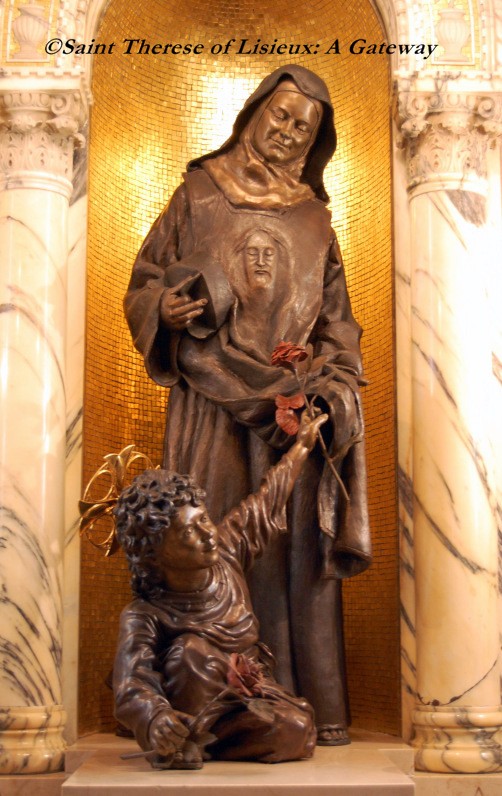
This statue of St. Therese as a Doctor of the Church was given to the Carmelite Monastery in Philadelphia in 1997, the year she became a Doctor. In one hand she holds the biretta, the symbol of the doctorate. A child reaches up to grasp the rose in her other hand. The image of the Holy Face appears on her scapular.
The statue is located in the chapel, in the exact spot where, for nearly a hundred years, the portrait of Therese painted by Celine which was given to the Philadelphia Carmel was displayed on Therese's feast.
St. Therese's Images of Mary - May 31, 2017 - New! Text of the Act of Consecration by which Therese became a Child of Mary on May 31, 1886
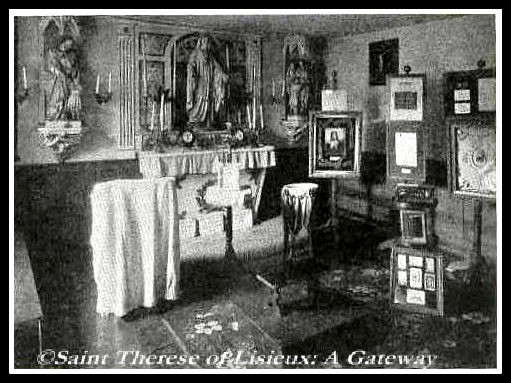 Oratory of the Children of Mary, Benedictine Abbey, Lisieux. Souvenirs of St. Therese's schooldays and of her reception as a Child of Mary. Photo Credit: The Far East.
Oratory of the Children of Mary, Benedictine Abbey, Lisieux. Souvenirs of St. Therese's schooldays and of her reception as a Child of Mary. Photo Credit: The Far East.
St. Therese of Lisieux and the Children of Mary
It was on May 31, 1886 that Therese Martin, then thirteen years old, was received as a Child of Mary at the Benedictine Abbey of Notre Dame du Pre where she had until recently been a student. The organization of the “enfants de Marie,” whose members consecrate themselves to the Blessed Virgin for life, is known in some English-speaking countries as the Sodality of Mary. All five of the Martin daughters were members (Marie and Pauline having been received at the Visitation school at Le Mans where they studied), and Celine had been president of the chapter of the Children of Mary at the Benedictine Abbey where the three youngest Martin girls were students.
Therese Martin as an aspirant for the Children of Mary
On February 2, 1885, the feast of the Presentation of Mary, Therese, just turned 12, had been received as an aspirant into the Children of Mary. But, at Easter 1886, when her father decided that she must withdraw from the school due to her frequent illnesses, she had not yet become a full member. Solemn reception into the Children of Mary at the Abbey happened only twice a year on two great Marian feasts: December 8, the feast of the Immaculate Conception, and on May 31, the feast of the Visitation.
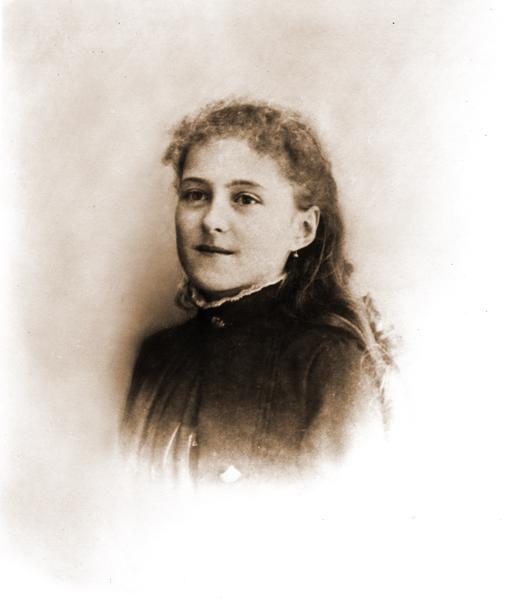 Therese in February 1886, a few months before she was received as a Child of Mary. Courtesy of the Web site of the Archives of the Carmel of Lisieux
Therese in February 1886, a few months before she was received as a Child of Mary. Courtesy of the Web site of the Archives of the Carmel of Lisieux
Therese tells in her memoir how, not wishing to be less a child of her heavenly Mother than her Sisters had been, she went to Mother St. Placide and asked the favor of being received even though she was no longer a student. Mother St. Placide had to consult the president and counselors of the Children of Mary. As the request was Irregular, they hesitated at first, but Mother St. Placide said prophetically (no doubt without realizing it): “I don’t believe that you will ever have any reason to regret having admitted Therese Martin into the sodality.” As a condition, Therese was obliged to come to the Abbey twice a week in the afternoon, from one o’clock until five o’clock. (All former students were allowed to attend the afternoon classes in drawing, needlework, and painting). She writes of how, after the lesson, she spent the rest of the afternoonbefore the Eucharist, “Jesus . . . my only Friend.” At this time Therese was still technically an aspirant, for the members received new girls only by voting for their admission. The vote was taken a few days before May 31, and Therese was admitted.
Therese Martin's reception as a Child of Mary on the Feast of the Visitation, May 31, 1886
The solemn ceremony of reception was celebrated in the Abbey chapel where Therese had received her First Communion on May 8, 1884. So Therese was consecrated as a Child of Mary before the same altar where she had recited the Act of Consecration on her First Communion day.
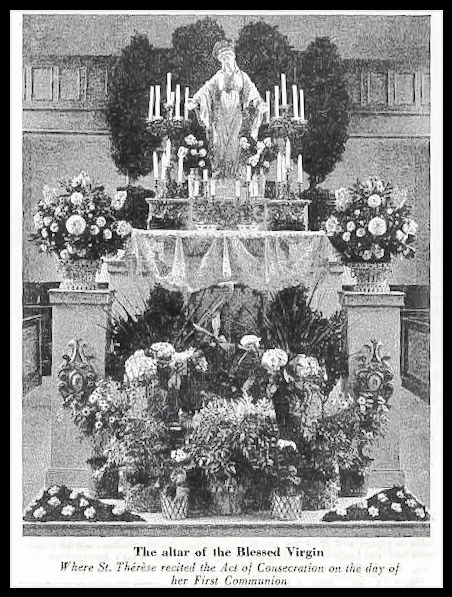 The altar and the statue before which St. Therese was consecrated as a Child of Mary, May 31, 1886
The altar and the statue before which St. Therese was consecrated as a Child of Mary, May 31, 1886
St. Therese's blue ribbon and medal as a Child of Mary
That day, Therese received the blue ribbon and the medal worn by the Children of Mary. Hers, destroyed in the bombing of Lisieux in 1944, was identical to the ribbon and medal pictured, which were displayed at Lisieux in 2009 and which could have belonged to one of her sisters or to another Child of Mary of that time.
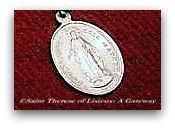 Medal of the Child of Mary. Photo credit: Peter and Liane Klostermann
Medal of the Child of Mary. Photo credit: Peter and Liane Klostermann
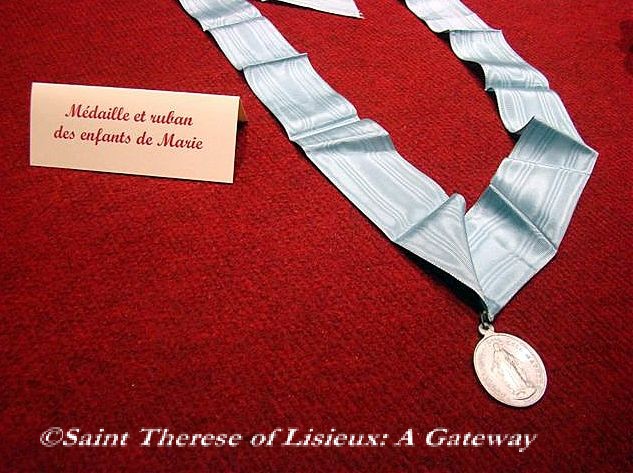 Blue ribbon and medal of a Child of Mary, displayed at Lisieux in 2009. Thanks to Peter and Liane Klostermann for the gift of this photo and to the Pilgrimage Office at Lisieux for permission to display it.
Blue ribbon and medal of a Child of Mary, displayed at Lisieux in 2009. Thanks to Peter and Liane Klostermann for the gift of this photo and to the Pilgrimage Office at Lisieux for permission to display it.
The text of St. Therese's Act of Consecration as a Child of Mary
Thanks to the Southern Cross newspaper, I have the honor of re-presenting the English text of Therese’s Act of Consecration as a Child of Mary. This is not the same text as the consecration used on her First Communion Day.
" O Mary conceived without sin, I, Marie Françoise Thérèse Martin, wishing to be enrolled under your special protection, choose you as my Patron, Advocate, Mistress and Mother. At your feet I make the .firm resolution of working with all my might at spreading devotion to you. . I wish to make henceforth solemn profession of belonging to you .without reserve, of walking in your glorious footsteps and imitating your virtues, especially your angelic purity and incomparable charity. This promise I make at your altar before the whole Heavenly Court. Obtain for me, O tender Mother, the grace of being faithful to it during my whole life, that I may merit the favor of being your child for eternity. Amen."
The Oratory of the Children of Mary became the Oratory of St. Therese
Membership in the Children of Mary was a lifelong commitment. All the Children of Mary came to the Abbey on the first Sunday of every month to listen to a conference from the chaplain, Fr. Domin. The Benedictine nuns took care to influence the spiritual lives of their graduates, and every former student continued to attend these conferences until she married. Therese attended these monthly conferences until she became a Carmelite in April 1888; they were presented in the special oratory of the Children of Mary. Later it became the oratory of St. Therese, where pilgrims came to pray before the souvenirs of Therese’s schooldays. Her blue ribbon and medal and the parchment of her consecration were displayed there until they disappeared when the Abbey was destroyed in the bombing of June 6, 1944.
May Therese unite us more closely to Mary, who, as she wrote, "gives Jesus to us and unites us to Him."
St. Therese's Images of Mary - Celine's portrait of Our Lady nursing the Child Jesus - May 29, 2017
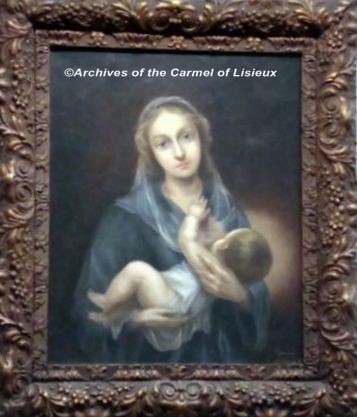 A tableau of Our Lady nursing Jesus painted by Celine Martin at Therese's request. Displayed at Lisieux in the exposition of 2009. Fervent thanks to Peter and Liane Klostermann for the gift of the photograph and to the Pilgrimage Office at Lisieux for permitting me to display it.
A tableau of Our Lady nursing Jesus painted by Celine Martin at Therese's request. Displayed at Lisieux in the exposition of 2009. Fervent thanks to Peter and Liane Klostermann for the gift of the photograph and to the Pilgrimage Office at Lisieux for permitting me to display it.
The idea for this painting originated with Sister Therese of St. Augustine, the sister whom Therese wrote "has the faculty for displeasing me in everything." (Paradoxically, Therese accepted Sister Therese of St. Augustine as a special friend in the community). The two women shared a devotion to what Sister Therese of St. Augustine called "our favorite subject, the Holy Infancy of Jesus," and the older nun persisted in asking the younger to write a canticle about it. So Therese wrote "The Divine Dew, or the Virginal Milk of Mary,"ACL her first poem, and gave it to Therese of St. Augustine on February 2, 1893, for the feast of the Presentation of the Lord.
Sister Therese of St. Augustine then suggested a painting along the same lines, and in the following months (1893-1894), Celine executed the painting. It was inspired by Raphael’s “Madonna del Granduca.” According to the caption when it was displayed at Lisieux in 2009, it was offered to Leonie nn February 3, 1895, during her second sojourn at the Monastery of the Visitation at Caen. This was undoubtedly for the Feast of the Presentation, a feast especially dear to the daughters of the Visitation. We know that Celine often retouched her portraits. Perhaps she asked to have this one back to improve it, for in Photos 16 and 17ACL of Visage de Therese de Lisieux, the photos of the community at recreation in the chestnut walk, Celine can be seen retouching this painting.
Therese used a photograph of this painting to create a holy cardACL with the same image for her personal use.
References: see the introduction to this poem in The Poetry of Saint Therese of Lisieux, tr. Donald Kinney, O.C.D. (Washington, D.C.: ICS Publications, 1996), pp. 35-37. See also Sainte Therese de Lisieux: sa vie en images,Pierre Descouvemont and Helmut-Nils Loose (Paris: Editions du Cerf, 1995), pp. 300-301.
"ACL" above means that the link leads to the Web site of the Archives of the Carmel of Lisieux.
"Saint Therese, Doctor of the Church," an interview with Monseigneur Guy Gaucher, O.C.D.
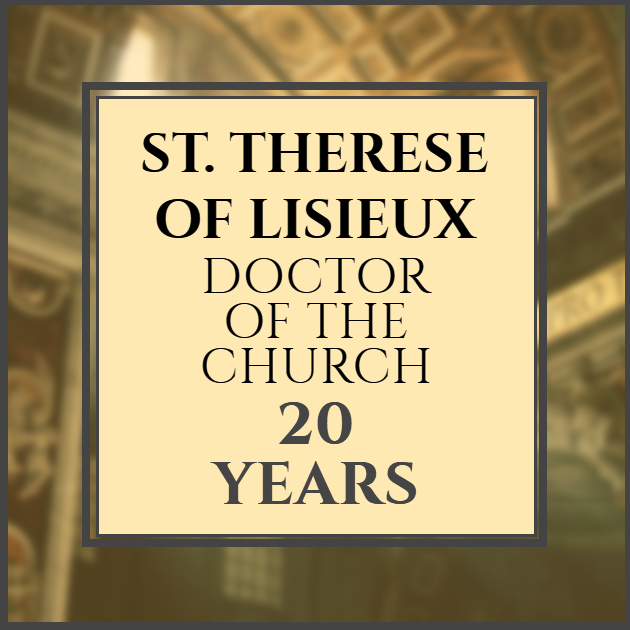

Bishop Gaucher after the Mass of Beatification for Louis and Zelie Martin in Lisieux, October 19, 2008
After St. Therese was named a Doctor of the Universal Church in 1997, her Carmelite brother, Bishop Guy Gaucher, who worked for a long time on the team that edited Therese's authentic works and who was instrumental in the process by which she was declared a Doctor, gave an interview on the significance of her doctorate. He explains what is required to be a Doctor of the Cnurch, tells how Therese became a doctor, and speaks of her importance as a woman doctor and a theologian. With thanks to the Shrine at Lisieux, please read "Saint Therese, Doctor of the Church: An Interview with Monseigneur Guy Gaucher."
"Over 60,000 at St. Therese's Canonisation" - a 1925 newspaper report for the anniversary - May 17, 2017
Over 60,000 at St. Therese’s Canonisation
His Holiness Proclaims New Glory of Carmel
All Nations Represented at the Happy and Impressive Event
[from the Freeman's Journal (Sydney, New South Wales, July 2, 1925]
 A Banner of St. Therese Displayed in St. Peter's for Her Canonization
A Banner of St. Therese Displayed in St. Peter's for Her Canonization
ROME, May 23.
The solemn Canonization of the little Carmelite, Sister Therese of the Child Jesus, who died in the cloister at Lisieux, France, in 1897, at the age of 24, an event long and eagerly awaited by millions of her devoted clients in all parts of the world, took place on Sunday last in the presence of a vast multitude numbering at least 60,000 persons.
In honor of the new glory of Carmel, the gigantic dome of St. Peter's Basilica shone brilliant in the flaming light of 5000 tallow candle torches, illumining the hills and plains for miles around and flashing the message of Therese's triumph. Beneath the glittering dome, gardens and palaces, streets and edifices were arrayed in unbelievable grandeur and beauty. From every, corner of Italy and particularly of Rome, throngs of people poured into the marvellous old City, all thrilling with expectancy and anxious to the glorification of her who is in the garden of the Saints, the Little Flower.
Within St. Peter's
This, the first Canonization of the Holy Year of 1925, was marked with most sublime and significant solemnities. Within St. Peter's, rare and precious brocades and velvets, crimson in colour, depended from walls and ceilings. Upon them the radiance of 25,000 electric bulbs threw brilliance almost celestial. Roses, symbolic of Therese, were gar- landed about the altar, the pillars and ceilings.
Upon the ancient hallowed walls of the vast edifice hung several life-size paintings of the Little Flower at various periods of her life; Therese at the feet of the Pontiff, Leo XIII. beseeching with childlike candor to be permitted to enter Carmel at the age of fifteen; Therese in the garden of the convent at Lisieux, standing beside the great Cross on her Profession Day; Therese robed for burial, her pure brow crowned with roses.
From early afternoon great crowds began to assemble about St. Peter's, the vast Square and side streets, and all entrances were choked with those who had come far in the hope of witnessing the Canonization ceremonies.
In order that the voice of the Holy Father might be distinctly audible to all within the Basilica, large amplifiers had been installed on the four corners of the Papal Altar (directly beneath the dome of Michael Angelo). Four thousand specially, constructed seats along the tribunes offered provision for some small fragment of the vast throng desiring admittance. About the massive aisles the Swiss Guards hovered on vigilant guard in order to preserve the decorum fitting the sacred spot and the occasion.
The Gorgeous Procession
At the hour set for the ceremonies, the long procession of representatives of religious Orders, ecclesiastics and prelates of high rank, many robed in gorgeous vestments, swept toward the great Altar. The Pontiff, Pope Pius XI, borne upon the Sedia Gestatoria, raised his hand, in blessing as he was borne along. The flabelli or large fans waving gently upon the Holy Father lent an atmosphere of .the Far East to the scene.
Absolute silence prevailed throughout the vast edifice as the procession moved on. It is estimated that fully 30,000 French Catholics, 12,000 Americans and 10,000 English speaking Catholics were present in the Basilica. Smaller groups of persons representing almost all other nationalities also participated. In the royal box which formerly sheltered Kings and Queens and Princes famed in history of the centuries, were representatives of the royal houses of several European countries. In other specially re served sections were illustrious states men and members of the nobility. Immediately following Pope Pius in the procession came over 200 Archbishops and Bishops from all over the world, clad in the sacred, vestments of their high office.
When, in 1923, the saintly young Carmelite, Sister Therese of the Child Jesus, the favored child of Heaven, was raised to the honors of the altar by Pope Pius XI and formally enrolled among the Blessed, it was believed that within a short space her Canonization would follow. And the reason was that, the treasures of her childlike love had been poured out abundantly upon a world war- swept, storm-tossed and weary of its wretchedness. Her appeal was universal, especially at a time when men craved for light and peace, for the favorite saying of this little Child of Carmel had been: 'Jesus! I ask of Thee only peace!'
In his memorable allocution of April 30, 1923, Pope Pius stressed the characteristics of a life that was lived in secret, known only to God and to the few chosen souls who surrounded it. The Holy Father declared on that occasion that it was this spiritual Childhood of which Therese was the exemplar, pleasing alike to God and men, that had won for the Little Flower such a rare place in the category of the Saints.
Patron of Soldiers
During the great World War Therese of the Child Jesus became the favorite advocate of those who were fighting the great fight in the sacred cause of democracy. Many favors were vouchsafed by her to her devout clients. Had the Little Flower of. Jesus lived, she would have been just fifty-two years of age to-day. But in the inscrutable designs of Providence, she was privileged to be of those who, having lived for a short space, fulfil a long time.
Unprecedented in the history of canonizations is the rapidity with which the Cause of the Little Flower has gone forward. But providential it surely is, since it is but the echo on the lips of the world, of that age-old cry which Augustine voiced centuries ago: — that the human heart is ever restless until it rests in God. And whosever can show the quickest way to peace is the Angel of Peace to souls that are weary of exile and longing for deliverance from a multitude of woes. To win God by caresses, 'to cast before Jesus the flowers of little sacrifices, to show men a new little way, very easy and very short, by which to go to Heaven,' — this is the mission of Saint Therese of the Infant Jesus whom all the world loves by the name of the Little Flower.
The Canonization of this dear little Saint of our own day is but the outward expression and recognition, of. the Church for the mission so faithfully performed, for the knowledge vouchsafed to men through her holy life and words, the knowledge that in the simplicity of the common way great sanctification may be attained, and man's age-old quest, the Heart of God, won at the cost of no very great or striking sacrifice.
Retrieved May 17, 2017, from http://nla.gov.au/nla.news-article116764741